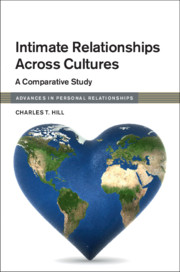Book contents
- Intimate Relationships Across Cultures
- Advances in Personal Relationships
- Intimate Relationships Across Cultures
- Copyright page
- Epigraph
- Contents
- Figures
- Tables
- Spotlights
- Collaborators
- Foreword
- Acknowledgments
- Introduction: Why Was This Book Written?
- 1 How Do We Know What Matters in Intimate Relationships?
- 2 Why Do People Seek Intimate Relationships?
- 3 How Are Intimate Partners Selected?
- 4 What Is Love and How Is Intimacy Expressed?
- 5 How Do Sexual Attitudes and Behaviors Matter?
- 6 What Are the Dynamics of Exchange and Power?
- 7 How Do Couples Cope with Conflict?
- 8 How Do External Factors Matter in Intimate Relationships?
- 9 How Do Intimate Relationships Relate to Well-Being?
- 10 How Do the Predictions Combine in Comprehensive Models?
- 11 How Much Do the Levels of Factors Vary?
- 12 What Are the Implications of the Study?
- 13 How Might the Findings Apply to Other Social Relationships?
- Epilogue: What Future Research Is Needed?
- Glossary of Statistical Terms
- Boston Couples Study Publications
- References
- Index
1 - How Do We Know What Matters in Intimate Relationships?
Published online by Cambridge University Press: 21 June 2019
- Intimate Relationships Across Cultures
- Advances in Personal Relationships
- Intimate Relationships Across Cultures
- Copyright page
- Epigraph
- Contents
- Figures
- Tables
- Spotlights
- Collaborators
- Foreword
- Acknowledgments
- Introduction: Why Was This Book Written?
- 1 How Do We Know What Matters in Intimate Relationships?
- 2 Why Do People Seek Intimate Relationships?
- 3 How Are Intimate Partners Selected?
- 4 What Is Love and How Is Intimacy Expressed?
- 5 How Do Sexual Attitudes and Behaviors Matter?
- 6 What Are the Dynamics of Exchange and Power?
- 7 How Do Couples Cope with Conflict?
- 8 How Do External Factors Matter in Intimate Relationships?
- 9 How Do Intimate Relationships Relate to Well-Being?
- 10 How Do the Predictions Combine in Comprehensive Models?
- 11 How Much Do the Levels of Factors Vary?
- 12 What Are the Implications of the Study?
- 13 How Might the Findings Apply to Other Social Relationships?
- Epilogue: What Future Research Is Needed?
- Glossary of Statistical Terms
- Boston Couples Study Publications
- References
- Index
Summary
To understand the present study, it is important to have certain tools for thinking. These include conceptual tools, which consist of the concepts used to categorize study participants for comparisons, as well as theoretical concepts for explaining which factors were measured and why they matter. They also include statistical tools for making comparisons and determining how much the factors matter. Statistical tools are used to reveal the results throughout this book. This chapter reviews these conceptual and statistical tools to facilitate the reader’s understanding of this study, as well as other research on intimate relationships.
There are various ways of being intimate, including physical (touching, hugging, kissing, sexual), emotional (sharing feelings), cognitive (sharing thoughts), and experiential (sharing activities), as noted by Kakabadse and Kakabadse (2004). There are also many kinds of intimate relationships, including friendships, dating, marriage, and other relationships among family members or non-relatives. This book focuses primarily on dating, marriage, and other romantic or sexual relationships.
- Type
- Chapter
- Information
- Intimate Relationships across CulturesA Comparative Study, pp. 4 - 35Publisher: Cambridge University PressPrint publication year: 2019

